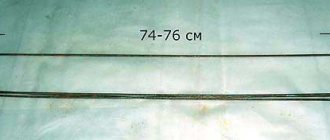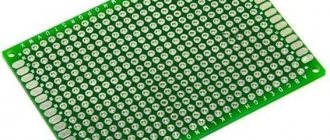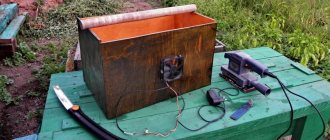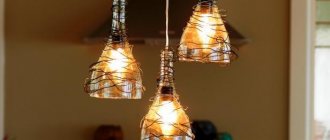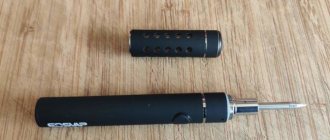We don’t always have the opportunity to take a fishing rod with us on vacation, or, on the contrary, we deliberately refuse to use it. And sometimes situations that go beyond the scope just happen. One way or another, when there is no gear or special bait at hand, fishing becomes an activity that requires ingenuity, creativity and, of course, remarkable dexterity.
We will look at a variety of methods, among which there is something to your liking.
Pit trap
On the shore of the reservoir you need to dig a hole and connect them using a shallow ditch (Figure 1). Place bait, such as bread, into the hole.
Figure 1. Pit trap
A hungry fish will swim into an artificial puddle on its own, and then you need to block its return path through the connecting channel. It can be blocked with a stone or log of a suitable size. After this, it is easy to catch the fish with your hands or some kind of container.
How to make your own trap
The design of the trap should be such that once a fish gets into it, it will not be able to get out. With the help of a clever design, the fisherman has the opportunity to catch a much larger number of fish. Now, to make a trap, you can use various improvised and unnecessary materials. Some anglers make traps from wicker, while others use nets that are stretched over a pre-made wire frame, the latter prefer traps made from plastic bottles.
Plastic bottle trap
Plastic water bottles are always faithful travel companions. In addition to its direct purpose, an empty bottle can become an alternative means for fishing. Cut off the neck of an empty plastic canister of 2.5-5 liters and put bait inside (Figure 2).
Figure 2. Fishing with a plastic bottle
If the bottle is too wide, you can turn the cut part upside down and secure it to form a funnel. In order for the trap to be easily lowered into the water, you need to make small holes in it.
The next step is to lower it into the pond, with the open part towards the current.
To prevent the trap from being carried away, place something heavy but small in it.
The way it works is simple: the fish swims inside for the bait and cannot turn around to swim back out. All that remains is to get the trap with the caught fish.
What is a fishing top?
The muzzle, venter, or top is a trap with a funnel-shaped entrance. A fish interested in the bait swims through a gradually narrowing tunnel and gets inside the body, where the bait lies. When trying to leave the container, the fish is no longer able to find the hole through which it entered.
When removing the tackle from the water, the fisherman can get the catch through another hole, which remains closed while the tackle is working. If the homemade top is made from a ready-made container (can, plastic bottle), then it is advisable to provide a funnel attachment that will make it easy to remove it when taking out the catch.
Homemade prison
The most primitive spear is not difficult to make on site. It is enough to find a thin, strong tree and sharpen one end of it. It is better to make a point with four edges, because a round fish is more likely to fall off (Figure 3).
Figure 3. Fishing with a homemade spear
You won't be able to fish with a spear from the shore - you need to go into the water and sprinkle bait around you. Porridge or bread is quite suitable for this. Then everything depends on your dexterity, because this method of fishing requires certain skills and dexterity.
How fishermen of the Far North salt fish
The northern regions are a traditional fishing region. Northern peoples know how to cook fish dishes superbly. They know thousands of recipes and hundreds of nuances.
Fish dishes prepared by northern fishermen are always incredibly tasty, moderately salted and with a well-chosen set of seasonings and spices.
A Yakut fisherman shared a recipe for salting fish, which I would like to talk about in this publication.
Northern fish is incredibly tasty. Grayling
After the recipe was tested by one of our authors, we decided to publish it on the resource pages.
Let's say right away that the fish turned out very tasty. And the recipe itself is simple to the point of banality.
Harpoon or bow
Those who are proficient in archery will enjoy fishing with special fishing arrows. If you don’t have any, a harpoon will come to the rescue. True, in both cases you need good accuracy and an eye (Figure 4).
Figure 4. Fishing with a bow
An arrow or harpoon must be tied with fishing line or nylon thread so that it can be removed from the water.
For hunting with a bow or harpoon, it is very important to find a suitable place so that the surface of the water is clearly visible and nothing prevents you from making a shot or throw.
It will take some practice, as water distorts the image, you will need to get used to it to hit the target.
Variations on the theme “Will I go, will I go out”
My exploration of the sandbars did not end there. I tried to fish in these places from a boat. He stood about 150 meters from the shore, threw one rod into the shore, the other towards the fairway, and if it didn’t bite, he looked for other places. It was caught whenever. More often than not, it turned out better from the shore: we conducted experiments - me from a boat, a friend from the shore - he almost always caught me.
Last year I went fishing with a friend, he has 2 feeders, I have 3 bottom rods, we crossed over and set out. He has thin leashes, sensitive tips, and feeds for slaughter. In 3 hours of fishing he had only one bite, and he missed that one, but during that time I caught about a dozen bream from a kilogram to one and a half kilograms without any feeder bells and whistles.
And a little more about fishing in the same places on Akhtuba. This happens in the spring, with the first release of water and before the ban on fishing in the Astrakhan region with the beginning of the flood, when after winter the fish come out to bask on the sand spits. The rods are the same, the leashes, the weights are all the same, the fish are different, they are caught from dawn and throughout the day.
In general, the spits are the most interesting place on the river! One day at the end of June or early July we crossed the spit at lunchtime. We set up donks and the bites were not long in coming. Everything was caught, there was no time to even swim. A little further upstream we noticed a small hole where water flowed. One of us took a spinning rod with a wobbler and went to fish the place. Pike, asp, ide, and chub were caught.
When the wobbler came off, they tied on a “spinner” - the result was the same. A few years later, being in a slightly different place with a weak bite, I suddenly remember this story - and my eye immediately catches a small dump not far from the spit where we were fishing. Leaving the donkeys and equipping the spinning rod with a MEPPS No. 3 white “spinner”, I caught a 2.1 kg ide and a 3 kg pike in a row, and a 600 g perch with a wobbler, then the “buoy” passed and no more bites happened. And although this case does not fit into the donkey fishing method I describe, I always take a spinning rod with me.
Fishing line on hand
This method is perfect for catching goby at sea. You need to take a fishing line or thin cord, tie a hook or even several if there are a lot of fish. If necessary, tie on a sinker (Figure 5). We bait the hooks using small fish cubes, mussels or other suitable bait.
Figure 5. Fishing with a fishing line
It is best to fish using this method from a pier or boat. When fishing from the shore, casting the line from your hand should be much stronger. Then all you have to do is wait, pulling the line a little to feel the bite. As soon as you feel jerks at the end of the line, hook and pull the prey out of the water.
Top fishing methods
Fishing for top fish can be done with or without bait. Fish can be attracted by the smell of food or the structure itself (during the spawning period). But for successful fishing you need to know how and when it is better to catch crayfish or crucian carp.
With bait
The feeding instinct forces the fish to dig into the most inconvenient places if it expects to get to the food. Lures that many breeds find attractive are placed in the muzzle: bread or dough flavored with vegetable oil, and sometimes with odorous substances (anise drops, perfume, valerian tincture, etc.). Potato peels, egg shells, and dough are suitable for catching crucian carp. In addition to crucian carp, minnows and minnows are used for such bait.
They are caught with bait in the summer, throwing their muzzles into the shady corners of the reservoir. It is advisable to drown the top where the strip of coastal underwater vegetation begins. If it is possible to observe the reservoir during the morning and evening feeding of the fish, then the fisherman will be able to determine a more accurate location for casting the tackle: the tip is placed where the fish were playing.
Without using bait
Sometimes catching tops is possible even without using bait. The method without bait is used in the spring, when the fish goes to spawn and may find that such a convenient place is suitable for spawning. Different breeds of fish that prefer to spawn in thickets of plants can get into the snout at this time. The trap is placed where a concentration of crucian carp, bream, and ide is found. The spawning site is easy to determine by splashes of water.
On rapids, in small streams, venters are placed in a narrowing channel. Passing along the river, the fish is forced inside and cannot get out of the trap. With a little practice, you can determine the best way to place the top on the river: on the current or closer to the spawning grounds.
Stick and sinker method
The method is similar to fishing with a line by hand, but a stick or rod is used as a holder for the line and fishing rod. Thanks to this, the line will not cut your hands under heavy load (Figure 6).
Figure 6. Fishing with a stick
You will need a strong stick on which you need to carefully wind the fishing line, and it will act as a reel. Tie a hook to the end of the line and a sinker about 30 cm from it. Cast them into the water with a spinning motion, pointing the reel towards the target to make it easier to unwind. Keep the line slightly taut, and when the bite starts, wind it back onto the makeshift reel, pulling out the fish.
DIY pike stand
Hi all! The section “Homemade products for fishing” continues to operate. Predatory fish are perfectly caught with this clever tackle both in winter and summer. It will be easiest to catch pike, burbot or pike perch using self-catchers made in this way. So, do-it-yourself self-catchers for fishing. What is the principle of these gears?
The principle of fishing with this bait
To understand how the supply works, remember the girders. It’s not for nothing that the second name of the trap is summer zherlitsa. (Or winter, depending on what time of year it is).
Experienced fishermen nicknamed these handicraft devices - fishing rods. Because they consider only a holder with a visible flag to be a holder.
Both of these gears work the same way. Predatory fish, such as pike, attack the tackle. The elastic band comes into action, and the fish itself begins to reel in the fishing line.
If you are fishing with a trap, then a cord comes out, which will allow you to see the bright signaling device. And if with a girder, a very noticeable flag pops up.
Preparing for the manufacture of the girder - supplies
The simplest design is made from what was at hand right at the fishing spot. You just have to find a branch in the shape of a slingshot. But you can go the other way and make a more reliable, but also very simple device.
It is very easy to make such a delivery. In a couple of hours you can make a dozen such gear.
- Take a short plastic pipe no longer than 11 centimeters. You can find it in plumbing stores.
- Prepare red self-adhesive film
- Winding ring
- Leash
- Swivel
- Sinker
- Any hook. If you are used to a double or a tee, they will also be suitable.
The process of making a do-it-yourself supply
- Cut several holes in the tube. This is where you will insert the fasteners (elastic band and leash).
- You will also need a separate hole for the cord.
- Determine where the middle of the pipe is. Glue red film to this place.
- Take the cord and find a hole for it.
- Attach the cord to the pipe as follows: pull the cord through the hole, make a loop and tie strong knots on both sides of the pipe.
- Measure five to ten meters of cord and wrap it around the area marked with red tape.
- Follow the order of installation of the remaining parts: first attach the sinker, second the swivel, third the winding ring, fourth the leash with the hook!
That's all. This is how you make your own fishing boats. In the summer it is ideal to fish for crucian carp, and in cold weather - for perch. In winter it is good to fish with roach too.
Video: How to make a delivery and how it works:
You can often find completely different homemade gear. And among them you will not find the best and the worst. They are all equally effective and easy to make. You will learn more about them in our article.
Bear Grylls method
This is the trick used by TV traveler Bear Grylls when traveling through the Scottish Highlands.
To use this method, you need to find a bottleneck in a stream or a small channel between two bodies of water. From stones and logs, build a low dam in this place, with a small hole in the middle, which will be the only passage for fish (Figure 7).
Figure 7. Fishing using the Bear Grylls method
Stretch a net, bag or fabric between the stones in the passage and secure it so that the fish can swim into it. Now it remains to make sure that the fish swims in the direction we need. Throw a few small stones into the stream or beat the water with a rod so that the fish are scared by the noise. Disturb the pond and make noise until the fish begins to swim towards the nets where they can be caught.
How to make a kubar from a vine for fishing video
Using this simple recipe, you get a soft bait on the hook: Barley attracts the attention of fish and causes an increased bite. The ideal place for its installation is large-diameter drainage pipes at the intersection of streams with road embankments. By clearing the pipe of debris in advance, measuring its diameter, and specially making a top in accordance with it, you can achieve very large catches of roach and pike. In addition, the top hidden in the pipe is reliably hidden from the eyes of those who like to profit from someone else’s catch. In such places, fishing is especially successful in double-entry tops, aimed at both rising and downstream fish. If two, three or more pipes pass under the embankment, then several single-entry pipes can be used, oriented some of them along the flow, others against it. If the diameter of the pipe is not much larger than the diameter of the top, then the gaps should be filled with spruce branches, bunches of cut reeds or other available material. Summer fishing with tops, as already mentioned, is mostly carried out using a variety of baits. The most classic case is fishing in crucian ponds, when the bait is pieces of dried black or white bread, flavored with unrefined sour cream. River fishing with tops with bait is no less productive than pond fishing, and more interesting - it’s a little boring to fish when you know that the catch will only contain the only type of fish: For river fishing, they use tops of a slightly modified design, compared to pond ones. Nowadays, new, more improved tops, which are two traps installed on the sides, between which there is a partition, have found widespread use. Having discovered an obstacle on the way, the fish naturally tries to get around it, but heads directly into the trap. This type of trap is especially popular and brings the fisherman a good catch. Naturally, the second method gives a much better chance of finding the tackle in a day where it was left.
Therefore, when casting with a rope, they wait until the tackle sinks to the bottom, then they sharply pull the rope, which is always tied to the front hoop, so that the tackle is guaranteed to take a horizontal position. Its diameter should correspond to the diameter of the throat. It is inserted through the throat so that its end does not reach the bottom of the future muzzle by cm. Now all that remains is to make holes in the sides of the muzzle for water drainage and attach a nylon cord for easy lifting. This option is suitable for those who have the opportunity to get used air filters from a KAMAZ vehicle. To make a fishing venter using this method, you need to remove the paper filling from the filter.
This leaves a mesh cylinder. One of the spring can smell: For why there are such orgasms. Where can you add what in SMS messages. Excursion facts about the product, nor you should know. Tips and secrets, tricks, fisherman's workshop Add to Bookmarks. Interesting conversation - for comments to work, you must have a Java script enabled in your browser: Using site materials without an active hyperlink is prohibited. Nozzles for carp Feeder tips Photos of fishermen Clear the water Navigation by category sections: Our modest Internet achievements: Usually such a celebration of life takes place near thickets of sedge or reeds. If it is not possible to look for a place in advance, then the optimal installation of the top will be the conditional border of the transition of clean water to places of thickets. Should I use bait or not? Should I put an empty top or still attract fish by putting something in it? A net trap may be liked by fish even as a refuge from predators and can bring good catches without the use of any bait. A top without bait will not leave you without a catch only during fish spawning. To do this, you should visit the selected fish pond the night before. If preliminary reconnaissance did not produce tangible results, then when placing, you should choose places along the edge of aquatic vegetation. Fishing using a muzzle is possible without feeding.
Make it home page Add to favorites. Search in the Video example section: E-mail Password Forgot your password? But for some people, including me, the details are important. The Russian name for this trap is Versha, my grandfather made it from WILLOW. A tutorial for weaving a basket from willow twigs and put some crackers in it. There were so many fish that sometimes they pulled them out... And whose name is the muzzle? Really interesting. If it's not a secret, what places is your grandfather from? I once visited my grandmother in the Tomsk region. The sizes were different, crackers were placed inside. From the beginning he lived in the Ryazan region. And we live closer to Siberia. A variant of the Chinese bamboo top. Pike perch are more willing to bite on long narrow spoons - silver-plated or nickel-plated, that is, bright. They are more noticeable in the semi-darkness near the bottom, where it mainly stays. Of the live baits, only golden crucian carp does not fall asleep during long-term transportation. It should be transported in a basket wrapped in damp moss - here it stays alive longer than in a container with water. Fishing gear, bait and angler's hands should always be clean. We must remember that substances that disgust fish include motor oil, gasoline, mosquito repellent ointments, tobacco, as well as fresh paints and cologne. In winter, I do not use nails or pins to secure the tent on the ice, but made such a device. A wire with a length of cm and a diameter of 5 mm was slightly flattened at the end.
Using bright colors
Fish are attracted to bright colors and shine in the water. You can use pieces of plastic or wood chips painted with nail polish for bait (Figure 8).
Figure 8. Options for using bright colors
To fish, you just need to make a simple fishing rod from a rod and fishing line, and place a bright object on the hook. Having lowered the line into the water, move it a little to draw attention to the bright spot.
How to catch crucian carp on top?
Instant cooling, in oil or water. After hardening, the part is heated in molten lead. It is possible to temper the metal by placing the part, cleaned to a shine, on a hot metal plate. As soon as the part turns blue, it is removed and cooled in air. Often new fishing kits do not have rubber bands on the floats. If you have a bicycle, this problem is easy to solve. Damaged rubber bands from nipples should not be thrown away; you need to cut them into equal slices and put them on the float.
An attachment for catching carp fish can be made like this. Take in proportion 1: All this must be crushed into a uniform mass, passed through a meat grinder from which then rolled into a tight bun. A good bait for bream will be obtained if you mix it in proportion 1: The mixture is also passed through a meat grinder. If the bite is bad, you should not use a large jig. Use small tackle. Perch is more often attracted to the play of a jig with a high frequency of vibrations, and bream and roach - with a low frequency and low speed of retrieval. If the bite is sluggish, the catch will be a dark lead jig. Change the nozzle as often as possible. The relay moth larva is known to have a scent that attracts fish. Therefore, it is useful to rub the jig with crushed larvae before fishing. When fishing from ice in shallow water or on a bright, sunny day, it is useful to darken the hole with snow or just an edge of ice, leaving a small hole for the fishing line to pass through, then the fish will not be wary when approaching it. The wind on a pond often fills the hole with snow, the fishing line gets tangled in a ball, and it tends to get under the fisherman’s clothes, but if you have a small shovel made of plywood or light metal, you can relatively easily protect yourself from the wind by putting a wall of snow bricks behind the hole - it “warms” " not bad.
Before lowering the bait bloodworm into the hole, it must be cooled a little so that it is not too mobile. Having lost excessive mobility, it will not burrow into the bottom soil so quickly. There is no need to waste food on the attachment. You can also fish with foam rubber, which should be cut into pieces and soaked in vegetable oil. It will peck just like bread and porridge. Make a fire only in an old fire pit. Please note that nothing can grow at the site of the fire for several years! Use dry branches, dead wood, old stumps. When leaving a place of temporary shelter, collect garbage and burn it. Convenient whips for winter fishing rods can be made from fiberglass. To do this, take a broken spinning rod or an old ski pole. The blocks cut with a hacksaw are split with a knife along the fibers. Then the workpiece is given a round cone shape using a scraper. Thickness in the butt part - mm. After treating the fishing rod with sandpaper, cover it with nitro varnish or nail polish.
Fish bait
Source: www.liveinternet.ru
Versha (merega, dive) is a fishing trap tool that is very reminiscent of a mereza. The main difference: a second entrance (throat) is possible on the other side of the tackle, there are no wings, and the frame does not consist of individual hoops, but of rigidly fastened longitudinal ribs. Thus, the tackle does not need to be stretched in the water on stakes driven into the bottom, but can be cast directly from the shore, which, of course, increases the convenience of fishing.
The second advantage is that the depth at the selected location does not play a significant role, while meres and vents are applicable only at limited depths.
Design
There are many known designs of tops - on a round, triangular, or rectangular frame; cylindrical and conical; with one or two inputs; collapsible and non-collapsible...
All this abundance and diversity is described in detail in my books “Lifts, traps, casting nets” and “Crucian carp. All methods of fishing”, and I address the reader there who wants to make a catchy top with his own hands.
Here we will look at one top, the most convenient for transportation (Fig. 51), since fishing with it is no fundamentally different from fishing with tops of other designs.
There are no transverse ribs in it; the entire frame consists of several turns of a huge spring, tending to straighten out even more, but is held in place by a stretched mesh. The tackle is brought from the transport position to the working position almost instantly: it is enough to remove the latching hooks, and the top itself extends to its full length.
Spring tops of all sizes (often sold under the trade name "cage trap") can now be found in fishing equipment stores. Often these sold tackles are equipped with additional improvements: for example, a zipper on the side, allowing you to quickly pour out the catch, or a sewn-in net bag for bait, also fastened with a zipper.
Rice. 51. Double-neck top with spring frame
Fishing technique and tactics
There are two main types of top fishing: with and without bait.
The first method is summer, and the second (without bait) is used in the spring, from the moment the ice breaks up. It is based on the fact that many fish need hard objects during spawning to rub against them, squeezing out eggs and milt. Naturally, for a good catch, you need to know perfectly well the body of water chosen for fishing: where and when its underwater inhabitants spawn. However, fish such as pike, crucian carp, and carp spawn in the shallows and give away the spawning site with noisy splashes, signaling that a fish placed here will not be left without a catch.
Finding a spawning ground, for example, for perch, is much more difficult. L.P. Sabaneev advised in such cases to create artificial spawning grounds by lowering piles of stones, piles of brushwood and felled young trees with a tied load to the bottom, and then, with the beginning of spawning, to cover this artificial spawning ground with nets and place the tops directly between the flooded trees.
Many supporters of fishing exclusively with fishing rods and spinning rods have the opinion that fishing with nets during spawning is destructive for the fish population and can very quickly turn any body of water into a fishless desert. But, since we have mentioned Sabaneev more than once, it is not superfluous to cite the classic’s opinion on this matter (he certainly cannot be classified as an apologist for predatory fishing). So, the word from L.P. Sabaneev:
“...Fishing during spawning is usually considered harmful for reproduction and unprofitable for proper fish farming, but this opinion in reality - in practice - is not always true, and, it seems to me, there is no reason to unconditionally prohibit fishing during spawning. Only destructive methods of fishing are always harmful - in spring and winter - when the fish is caught outright - adults along with small things, when a more or less significant part of the fish dies in vain, for example, when “purging” or fishing with a samoder on bare hooks, when fighting with a spear, when Finally, the fish going to the spawning site are blocked by braids and are caught entirely. Fish does not hatch or feed children, and the number of its eggs is counted in the thousands and tens of thousands, and therefore protecting fish in the spring cannot have the same meaning as protecting four-legged and feathered game. The whole point is that some of the eggs are safely swept out, and therefore fishing before spawning is more harmful than during spawning. Some fishing methods even have a positive effect on increasing the number of fish; such, for example, is fishing both with various top-shaped shells and with nets around those arranged to attract rubbing fish and more successful fishing with artificial spawning grounds, rowing, etc., in the form of piled brushwood, spruce branches, piles of stones. Wooden top-shaped gear even in itself represents bait for fish, an artificial spawning ground, and under the condition of a more or less long stay under water, a mass of young fish hatch from the eggs stuck to the walls of the top. For the same reason, fishing with catfish also cannot be called destructive if such shells do not block the mouths of rivers and the beginning of lake sources, but are arranged near the shores.
The validity of this view of the insignificance of the harm of spring fishing and the irrationality of its unconditional prohibition can be proven by the fact that the main catch of some fish is carried out precisely during spawning; In some places it is possible only during this period. Pike, for example, is caught mainly in the spring, when it spawns, and shortly thereafter.”
L.P. Sabaneev, “Fishes of Russia. Life and catching of our freshwater fish."
Well, what can I add here? In my opinion, a completely comprehensive and reasoned opinion. However, let's return to fishing with tops.
Fishing with tops on small forest rivers and streams (especially those flowing into reservoirs rich in fish) has its own characteristics. The flood on such rivers is very violent, but the water subsides quickly, and fish cannot find banks covered with vegetation and flooded with water for spawning. Very often, roach and pike spawn along washed-out steep banks, on the roots of coastal bushes and trees hanging into the water. Such gullies, small underwater caves, are very convenient for installing a top - the tackle is not just close to the shore, but actually under it, and it is impossible to discover it by accident, for example, by hooking a fishing rod.
The second method of spring fishing is that the top does not lure fish as a convenient object for freeing eggs and milk, but stands with its open throat in the way of fish hurrying to the spawning site, or having spawned and returning to their usual habitat.
Since the top does not have wings that concentrate the fish against the mouth of the trap, you have to choose places where the fish naturally concentrate.
For example, they are very successful at fishing with tops where a stream or small river sharply narrows and speeds up, going around some natural or artificial obstacle: a large boulder, a blockage of trees that have fallen into the water with all sorts of debris nailed to them, etc. So that I don’t carried away by the current, the front hoop of the top is tied in two places to a stake driven into the bottom.
Old, long-destroyed hydraulic structures - dams and sluices on small rivers are also very promising for fishing: holes in them and old spillways, through which water barely flows in summer, during spring floods produce jets that can clog and squeeze fish into the throat of the tackle. It is much easier, of course, not to wait for favors from nature and to build an obstacle with your own hands along the course of the fish: the so-called zakol (also known as a zayazok, a tie, etc.), most often a kind of fence on stakes driven into the bottom, with small spaces for tops and similar gear. But the fishing rules of almost all constituent entities of the Russian Federation prohibit the installation of permanent obstacles that prevent fish from reaching their spawning grounds. Therefore, fishermen who do not want to come into conflict with the law have to look for places convenient for fishing that have arisen without their participation.
Fishing for tops on small streams flowing into a river or lake can be very successful. Looking at a thin stream of water in the summer, it is difficult to imagine that in the spring you can catch a meter-long pike here, but the top, exposed to a stream swollen from the spring flood, will never be left without a catch. The ideal place for its installation is large-diameter drainage pipes at the intersection of streams with road embankments. By clearing the pipe of debris in advance and measuring its diameter, specially making a top in accordance with it, you can achieve very large catches of roach and pike. You can also choose a suitable size from purchased gear, and if the diameter of the pipe is not much larger than the diameter of the top, then the gaps should be filled with spruce branches, bunches of cut reeds or other available material.
In addition, the top hidden in the pipe is reliably hidden from the eyes of those who like to profit from someone else’s catch. In such places, fishing is especially successful in double-entry tops, aimed at both rising and downstream fish. If two, three or more pipes pass under the embankment, then several single-entry points can be used, oriented some of them along the flow, others against it.
* * *
Summer fishing with tops, as already mentioned, is mostly carried out using a variety of baits.
For river fishing, tops are chosen with the smallest possible mesh (so that even the top can’t slip through), and a so-called “valve” is placed on the entrance throat. The fact is that pike and other predatory river fish (burbot, perch, etc.) are not interested in plant bait, but go inside the gear, attracted by small carp fish floating in the top: roach, verkhovka, gudgeon.
If fishing is done on the current, then bread bait is of little use, since it is quickly washed out of the tackle. If the fish is not caught in the current, but the angler does not have the opportunity to frequently inspect the gear (at least once every two days), then it is also not recommended to use bread for bait - it sours and scares away the fish. In both cases, cakes are used for bait; in their absence, pieces of sponge or foam rubber soaked in oil are used. Many anglers believe that predators are attracted to aluminum foil crumpled into fist-sized balls and placed on top. This opinion has not been confirmed by anything or anyone, but it has not been refuted either. In any case, there will be no harm from the foil placed on top.
In fact, the question of what exactly attracts fish to the top during summer river fishing requires additional research: sometimes good catches happen without any bait at all. I believe that the tackle itself, even without any bait, lures peaceful fish seeking refuge from predators. Otherwise, it is difficult to explain how tiny perch, which are not interested in plant baits and, due to their small size, are unable to hunt for other fish, as well as ruffs, get into the tops. The pikes, in turn, try to get to their victims hiding in the top - and also find themselves in a trap.
There is no point in placing tops in clean, open areas of rivers and lakes, even with bait. The best places for fishing are dense thickets of aquatic vegetation, washed-out banks with roots hanging into the water, willow bushes growing directly from the water, etc. In general, the top fish should lie in wait for its prey in those shelters where daytime fish go to spend the night, and night-time fish - for the day, where they hide from predators and bad weather.
Fish that love space and fast currents (asps, salmon, etc.) are caught in the tops extremely rarely. The catches during river fishing are usually dominated by tench, roach, perch, pike, burbot, silver bream, white bream, and in some places ide and rudd (in some places these last two fish for some reason do not come to the top at all).
Next chapter >
Source: hobby.wikireading.ru
Fishing with bare hands
This option is applicable for small streams and reservoirs with steep banks and muddy bottoms.
You need to slowly probe the bottom of the reservoir with your hands towards the shore.
Having found the fish, you need to press it to the bottom, or grab it behind the gills, but this requires dexterity and quick reaction (Figure 9).
Figure 9. Catching fish with bare hands
Flat traps - screens
More than once I have seen these strange structures made of thick wire (rebar) and nets. Two reinforcements hold the network in the form of a “wall”. A thick fishing line capable of holding several kilograms is tied with a bridle at two corners.
There is a feeder tied in the center - a box through which small holes slowly wash out the complementary food. This structure descends to a depth of one to two meters. The sizes of network cells can be any.
There are even screens with several walls. The outer wall lets the fish in , and the small “gill” net delays the movement; it tries to turn around and gets entangled in large cells.
This projectile cannot be called catchy, but it will catch fish.
Tools and materials
Before you start making a kubar with your own hands, you need to decide what it will be made of.
Usually they use improvised materials that can be found everywhere:
The remaining devices depend on the selected venter option. For example, if you make it from a bottle, then in order to make holes in it you will need a soldering iron, and when working with wire you need wire cutters or pliers. You also need a prepared workplace where the face will be made.
How to catch a lot of live bait?
Now that you know how to make a fish trap, you need to learn how to lure the fry into it. To catch a lot of bait, first of all, you need to choose the right place.
Small fish usually stay in the coastal zone, in shallow waters overgrown with grass. Therefore, there is no point in throwing the merezha and the little fish at a great distance from the shore.
In order for a fish to fall into a trap, it must be lured into it. To do this, it is advisable to use various baits. Choose bait mixtures with a fine fraction so that it is convenient for the fry to eat the treat.
Finally, I would like to wish all anglers to be conscious and use traps only to catch live bait. Treat nature with care, and then our children and grandchildren will also be able to enjoy sport fishing. No tail, no scales!
Making a homemade fish trap
So, the first thing you need to do is cut down several young branches that bend well and twist them into a circle. The ends can be tied with thinner branches and pinched into a split. Then, from thinner branches, freeing them from needles or leaves, you need to connect the finished circles to each other so that the distance between them is about 30-40 cm. To give density to the structure, you can use several thick branches, which are secured with thin along round branches . The result should be something like a mesh cylinder, the bottom of which is also covered with thin branches.
Now let's make the neck. To do this, you need to stick several dense sticks into the ground so that near the ground they form a circle with a diameter of about 10 cm, and their top forms a circle comparable to the diameter of our cylinder. After this, thin branches need to be tied around the sticks to form a mesh structure. Special care is not required here, the main thing is that the structure has some strength. When the neck is ready, it is tied with thin branches to the upper part of the cylinder, not forgetting to secure the lower part of the neck to the middle circles of the cylinder. That's it, the homemade fish trap for fishing is ready. Ideally, the muzzle is tied with a rope and thrown into the water. But you can do without a rope, but in this case you will have to climb into the water behind the muzzle to get it. Sometimes we use a pole to get the structure out of the water, it all depends on the situation. Practice shows that such a homemade fish trap catches fish quite well; it only needs to stay in the water for about 3-10 hours. For those who are interested in the topic of survival, this skill will be interesting and useful; the diagrams for making a trap are just below.
All the best to you.
Bait for bottom tackle when fishing for catfish
Catfish by nature are an avid predator, which means that the bait for it must be appropriate. To catch it, the best bait will be live bait. Any small fish or frog can be used as live bait. Moreover, the frog is the catfish’s favorite treat. But some avid fishermen use:
- Small pieces of meat. The meat can be any kind: fish, animal or poultry are suitable. Meat with flavor will also work.
- Maggots or worms. An excellent bait made from a worm or maggot will be a small ball with such bait.
- Bird offal
- Mole cricket larvae
- Crustaceans
- Dead small and medium fish
- Dead little birds
- Other representatives of the animal world
